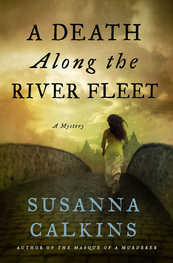 When I first began to conceive of A DEATH ALONG THE RIVER FLEET (to be released April 12, 2016!), an image came to me that ultimately informed the entire novel. That image was of a young woman, barefoot and clad only in her shift, stumbling at dawn through the rubble left by the Great Fire of 1666 (and yes, I am counting down to the 350th anniversary of the Great Fire! See counter to the right!) And, of course, I needed her to run into Lucy, so that my intrepid chambermaid-turned-printer's apprentice would have a reason to be involved in the mystery that follows. But it took me a while to figure out exactly where this encounter could reasonably occur. I thought at first the woman could be found on London Bridge. And I really wanted to write something about how the impaled heads of traitors, which lined either side of the Bridge, had caught fire. After all, in Annus Mirabilis Dryden had described in macabre detail how sparks had scorched the heads: "The ghosts of traitors from the Bridge descend, But then when I did a little more digging, I discovered that London Bridge had been damaged in the Fire, and really was not much of a thoroughfare in the months that followed the blaze. Indeed, there would have been no good reason for Lucy to be traveling in that direction, particularly so early in the morning. So I realized that, first, I needed to think through what Lucy was doing out of Master Aubrey's house, just before dawn. Not too hard to figure out actually. She needed to be delivering books. But then the question became, in what direction did she need to travel to deliver those books? Most people were living to the west of where the Fire had stopped. So why would she be going into the wasteland at all? To figure out this challenge, I began to systematically create a large scale map of Lucy's London using photocopies of reconstructed maps of the period. As I marked in red the burnt out area of London, I realized that the Fire line had been stopped to the west along the River Fleet. The River Fleet? This was not a river I knew anything about. A vague recollection that the Romans had used the river to transport goods, but I couldn't remember ever hearing about it otherwise. I became even more curious when I saw that several bridges, including the Fleet Bridge and Holborn Bridge, crossed it. Clearly, the river was wide enough or significant enough to require actual bridges, so it couldn't just be a stream. Intrigued, I began to read more about this mysterious river. From the maps I could see that the river flowed from the north, went through the Smithfield butcher markets, traversed Fleet Street, and emptied into the Thames. There was also a region that surrounded it, awesomely called "Fleet Ditch." [Sidenote: I really wanted my book to be called "Murder at Fleet Ditch," but that title didn't even make it past my editor. A little too stark, I guess.] 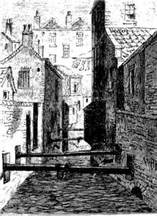 By all accounts, by the 17th century, the River Fleet was no longer a river where boats could easily travel, but had instead become a place where people would dump animal parts, excrement, and general household waste. Indeed, Walter George Bill, one of the great original historians of the Great Fire, described the River Fleet as an "uncovered sewer of outrageous filthiness." And yet, there were still accounts of people bathing in its waters (yuck) and even drinking from it (yuck, yuck, double yuck), despite its considerable stench and grossness. 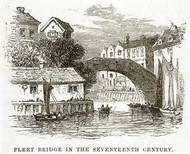 So the River Fleet--and the original bridges that crossed it--formed a natural backdrop for my story. I could not find a picture of the 17th century Holborn Bridge, but I thought this artist's rendering of Fleet Bridge might serve as a model. And because the Holborn Bridge was still in place after the Fire, with the unburnt area and markets on one side, and the burnt out area on the other, it became the perfect place for Lucy to encounter this desperate woman. 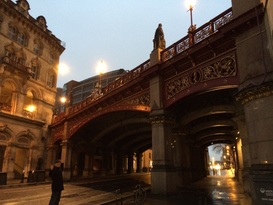 My friend Greg at modern Holborn Bridge... My friend Greg at modern Holborn Bridge... But of course, I was still curious...is there still a River Fleet? The answer is, yes, of course, but it was finally bricked over in the 1730s, after being declared a public menace. It was still problematic though, particularly in the 19th century, when a great explosion occurred as a result of the expanding gasses in the pipes below the streets. Raw sewage apparently spilled everywhere!!! (Don't even think I wouldn't use that awesome detail if I ever set a book in 19th century London. But I doubt it would make it to the cover!) And if you want to know more, here is a nice overview of the history of the River Fleet in all its--ahem--glory.
8 Comments
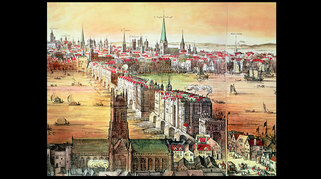 what bad event might have happened here? what bad event might have happened here? Since my first novel, A Murder at Rosamund’s Gate, was published in 2013, I have gotten many questions about my writing process. “Are you a plotter or a pantser?” is the question I most often get. Back then, I didn’t even know what the question meant. Now I know the questioner wants to know whether I outline my books in elaborate detail before I start writing (plotting), or do I go by the seat of my pants (pantsing), figuring out the plot and details as I go. I want to say that I’m usually captivated by an opening image—and that’s what my story revolves around. For my first novel, I have a young woman walking innocently up to a man she knows, who then surprises her by sticking a knife in her gut. Who was this woman? Why did she trust this man? And of course, why did he kill her? (Ironically, the image that inspired A Murder at Rosamund’s Gate never even made it into the final version. I had written it as a prologue, but I worried about starting the story twice. You can check it out here, if you are interested.). However, I've now learned that some things truly need to be figured out before I start writing the book. As I start my fourth Lucy Campion novel, I thought I'd try to share something of my process of thinking through the plot. I have my opening image, and--for now--a one paragraph description of the plot: When the niece of one of Master Hargrave’s high-ranking friends is found on London Bridge, huddled near a pool of blood, traumatized and unable to speak, Lucy Campion, printer’s apprentice, is enlisted to serve temporarily as the young woman’s companion. As she recovers over the month of April 1667, the woman begins—with Lucy’s help—to reconstruct a terrible event that occurred on the bridge. When the woman is attacked while in her care, Lucy becomes unwillingly privy to a plot with far-reaching political implications. So I have my opening image, but now I have to start thinking through all the big questions. Initially, I seem to do this as a reader. Who is this woman? What happened to her? What was this terrible event? Was it something that she witnessed, or is she physically injured. Whose blood is it? Why is she on London Bridge alone?
Then I will start the hard part--thinking through these questions as a writer. I've definitely learned that I need to figure out who the antagonist is from the outset. My natural tendency is to reveal the story to myself (pantsing), probably because I'm naturally more interested in how terrible events affect a community, not why people do terrible things. However, that approach usually means I don't know whodunnit, and that's a challenge for a mystery writer! I usually have to do a lot of backtracking and rethinking motivations and actions, when I have not worked out who the killer is upfront. So then, my next set of questions will be plot-related. What is this terrible event that occurred? Why did it happen? Who caused it to happen? How did this young noblewoman get involved in such a thing? And--sadly enough--I need to figure out if the London Bridge will work as a backdrop. I know it got burnt in the Great Fire, but I'm not sure yet how feasible it is that she ends up there. Then, because Lucy needs to be brought in, I need to figure out what makes this so urgent. Will this woman be attacked under Lucy's care? Probably. Why? What does she know? What are the larger implications of this crime. So, over the next week or so, I will brainstorm these big questions, and from there--voila!--a plot of sorts will emerge for me. I will figure out anchor points, motivations, and subplots from there. Then I will start writing. Every time I hit a roadblock, I will just start the questioning process again, until I figure out the direction I need to take to move forward. So I will call my approach, Plot-Pantsing. What about you? If you are a writer, what approach do you prefer? As a reader, do you think you can tell which approach a writer took? |
Susanna CalkinsHistorian. Mystery writer. Researcher. Teacher. Occasional blogger. Categories
All
Archives
May 2023
|

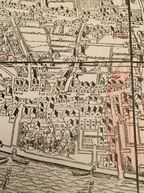
 RSS Feed
RSS Feed